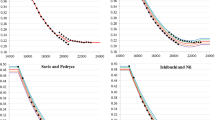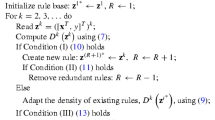Abstract
The aim of this paper is to compare different fuzzy regression methods in the assessment of the information content on future realised volatility of option-based volatility forecasts. These methods offer a suitable tool to handle both imprecision of measurements and fuzziness of the relationship among variables. Therefore, they are particularly useful for volatility forecasting, since the variable of interest (realised volatility) is unobservable and a proxy for it is used. Moreover, measurement errors in both realised volatility and volatility forecasts may affect the regression results. We compare both the possibilistic regression method of Tanaka et al. (IEEE Trans Syst Man Cybern 12:903–907, 1982) and the least squares fuzzy regression method of Savic and Pedrycz (Fuzzy Sets Syst 39:51–63, 1991). In our case study, based on intra-daily data of the DAX-index options market, both methods have proved to have advantages and disadvantages. Overall, among the two methods, we prefer the Savic and Pedrycz (Fuzzy Sets Syst 39:51–63, 1991) method, since it contains as special case (the central line) the ordinary least squares regression, is robust to the analysis of the variables in logarithmic terms or in levels, and provides sharper results than the Tanaka et al. (IEEE Trans Syst Man Cybern 12:903–907, 1982) method.


Similar content being viewed by others
References
Britten-Jones, M., & Neuberger, A. (2000). Option prices, implied price processes, and stochastic volatility. Journal of Finance, 55(2), 839–866.
Celminš, A. (1987). Least squares model fitting to fuzzy vector data. Fuzzy Sets and Systems, 22, 245–269.
Chang, Y.-H. O. (2001). Hybrid fuzzy least-squares regression analysis and its reliability measures. Fuzzy Sets and Systems, 119, 225–246.
Chang, Y.-H. O., & Ayyub, B. M. (2001). Fuzzy regression methods—a comparative assessment. Fuzzy Sets and Systems, 119, 187–203.
Diamond, P. (1988). Fuzzy least squares. Information Sciences, 46, 141–157.
D’Urso, P., & Gastaldi, T. (2000). A least-squares approach to fuzzy linear regression analysis. Computational Statistics & Data Analysis, 34, 427–440.
Ishibuchi, H., & Nii, M. (2001). Fuzzy regression using asymmetric fuzzy coefficients and fuzzified neural networks. Fuzzy Sets and Systems, 119, 273–290.
Jiang, G. J., & Tian, Y. S. (2005). The model-free implied volatility and its information content. Review of Financial Studies, 18(4), 1305–1342.
Kahraman, C., Beşkese, A., & Bozbura, F. T. (2006). Fuzzy regression approaches and applications. Studies in Fuzziness and Soft Computing, 201, 589–615.
Kao, C., & Chyu, C.-L. (2002). A fuzzy regression model with better explanatory power. Fuzzy Sets and Systems, 126, 401–409.
Kim, K. J., Moskowitz, H., & Koksalan, M. (1996). Fuzzy versus statistical linear regression. European Journal of Operational Research, 92, 417–434.
Moskowitz, H., & Kim, K. J. (1993). On assessing the H value in fuzzy linear regression. Fuzzy Sets and Systems, 58, 303–327.
Muzzioli, S. (2010). Option-based forecasts of volatility: an empirical study in the DAX-index options market. European Journal of Finance, 16(6), 561–586.
Nasrabadi, M. M., Nasrabadi, E., & Nasrabadi, A. R. (2005). Fuzzy linear regression analysis: A multi objective programming approach. Applied Mathematics and Computation, 163, 245–251.
Nather, W. (2006). Regression with fuzzy random data. Computational Statistics and Data Analysis, 51, 235–252.
Omrani, H., Aabdollahzadeh, S., & Alinaghian, M. (2011). A simple and efficient goal programming model for computing of fuzzy linear regression parameters with considering outliers. Journal of Uncertain Systems, 5(1), 62–71.
Peters, G. (1994). Fuzzy linear regression with fuzzy intervals. Fuzzy Sets and Systems, 63, 45–55.
Poon, S., & Granger, C. W. (2003). Forecasting volatility in financial markets: A review. Journal of Economic Literature, 41, 478–539.
Sánchez, J. A., & Gómez, A. T. (2003). Estimating a term structure of interest rates for fuzzy financial pricing using fuzzy regression methods. Fuzzy Sets and Systems, 139, 313–331.
Sánchez, J. A., & Gómez, A. T. (2004). Estimating a fuzzy term structure of interest rates using fuzzy regression techniques. European Journal of Operational Research, 154, 804–818.
Savic, D. A., & Pedrycz, W. (1991). Evaluation of fuzzy linear regression models. Fuzzy Sets and Systems, 39, 51–63.
Tanaka, H. (1987). Fuzzy data analysis by possibilistic linear models. Fuzzy Sets and Systems, 24, 363–375.
Tanaka, H., Uejima, S., & Asai, K. (1982). Linear regression analysis with fuzzy model. IEEE Transactions on Systems, Man and Cybernetics, 12, 903–907.
Tanaka, H., & Watada, J. (1988). Possibilistic linear systems and their application to the linear regression model. Fuzzy Sets and Systems, 27, 275–289.
Tseng, F.-M., Tzeng, G.-H., Yu, H.-C., & Yuan, B.-J. C. (2001). Fuzzy ARIMA model for forecasting the foreign exchange market. Fuzzy Sets and Systems, 118, 9–19.
Acknowledgments
The authors gratefully acknowledge financial support from Fondazione Cassa di Risparmio di Modena for the project “Volatility modelling and forecasting with option prices: the proposal of a volatility index for the Italian market” and MIUR.
Author information
Authors and Affiliations
Corresponding author
Rights and permissions
About this article
Cite this article
Muzzioli, S., De Baets, B. A comparative assessment of different fuzzy regression methods for volatility forecasting. Fuzzy Optim Decis Making 12, 433–450 (2013). https://doi.org/10.1007/s10700-013-9161-1
Published:
Issue Date:
DOI: https://doi.org/10.1007/s10700-013-9161-1




